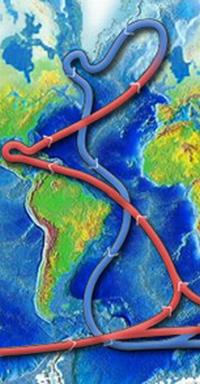 A new study has determined that the vast Atlantic Ocean current circulation system, including the Gulf Stream, is at its weakest in a thousand years. The slowing of the current, the Atlantic meridional overturning circulation (AMOC), could increase sea levels on the American East coast and may result in extreme weather in Western Europe.
A new study has determined that the vast Atlantic Ocean current circulation system, including the Gulf Stream, is at its weakest in a thousand years. The slowing of the current, the Atlantic meridional overturning circulation (AMOC), could increase sea levels on the American East coast and may result in extreme weather in Western Europe.
The AMOC is driven by two vital components of ocean water: temperature and salt. In the North Atlantic, warm, salty water flows northward off the U.S. coastline on the Gulf Stream and North Atlantic Current, carrying heat from the tropics. But as it reaches the middle latitudes, it cools, and around Greenland, the cooling and the saltiness create enough density that the water begins to sink deep beneath the surface.
The water then swings back southward and travels all the way to the Southern Hemisphere, submerged, where it makes its way to the Antarctic as part of a global system of ocean currents. The entire system is known as the ocean’s thermohaline circulation (“thermo” meaning heat and “haline,” salt), and it plays many critical roles in the climate. It is also referred to as the global ocean conveyor belt, because it redistributes heat worldwide.
In the North Atlantic, most important is the transport of heat northward, which has a moderating effect on Europe’s climate in particular. But the circulation can be weakened by making northern water more fresh and less salty, and therefore less dense. That’s what climate change — through a combination of more rain and snow, more melting of Arctic sea ice, and huge freshwater pulses from Greenland — is thought to be doing.
Stefan Rahmstorf, of the Potsdam Institute for Climate Impact Research, who co-authored the study published on Thursday in Nature Geoscience, told the Guardian that a weakening AMOC would increase the number and severity of storms hitting Britain, and bring more heatwaves to Europe.
He said the circulation had already slowed by about 15%, and the impacts were being seen. “In 20 to 30 years it is likely to weaken further, and that will inevitably influence our weather, so we would see an increase in storms and heatwaves in Europe, and sea level rises on the east coast of the US,” he said.
Thanks to David Rye for contributing to this post.

And as time goes on the circulation will stop and the good old gulfstream will no longer provide moderate temp in Europe and in a couple of hundred years e new ice age will hit the northern hemisphere.